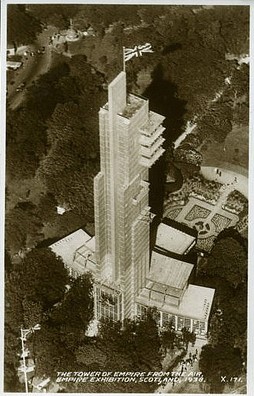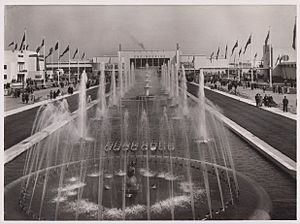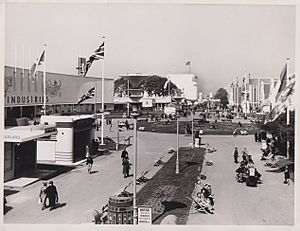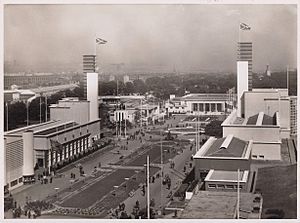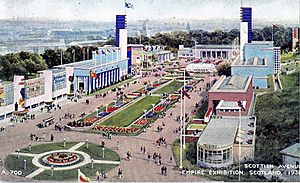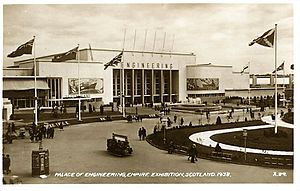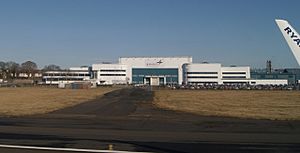Empire Exhibition, Scotland facts for kids
Quick facts for kids Empire Exhibition, Scotland |
|
|---|---|
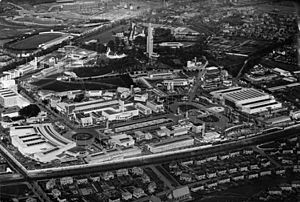
The exhibition in Bellahouston Park, showing the Mosspark Boulevard entrance and on the hill the Festival Tower, with Ibrox Park in distance beyond Paisley Road West
|
|
| Overview | |
| BIE-class | Unrecognized exposition |
| Name | Empire Exhibition, Scotland |
| Building | Tait Tower |
| Area | 145 acres (59 ha) |
| Visitors | 12.8 million |
| Organized by | Cecil Weir was chair of the council of management and the administrative committee |
| Location | |
| Country | United Kingdom |
| City | Glasgow |
| Venue | Bellahouston Park |
| Timeline | |
| Opening | 3 May 1938 |
The Empire Exhibition, Scotland 1938 was a huge international event, like a giant fair, held in Glasgow's Bellahouston Park. It ran from May to December in 1938.
It was a chance to show off Scotland's economy and celebrate trade within the British Empire. This helped the country recover from the tough times of the 1930s. It also marked 50 years since Glasgow's first big exhibition in 1888.
This exhibition was similar to the very first Great Exhibition held in London in 1851, which attracted 6 million visitors.
King George VI and Queen Mary officially opened the exhibition on May 3, 1938. The opening ceremony took place at Ibrox Stadium, with 146,000 people attending! The Exhibition President was the Earl of Elgin, who also led the Scottish Development Council, the group that first thought of the exhibition.
Contents
What the Exhibition Wanted to Achieve
The exhibition had five main goals. The fifth goal was especially important to show the world that the British Empire wanted peace, unlike some other countries at the time.
- To show how much the British Empire, both at home and overseas, had grown.
- To teach young people about the resources and potential of the United Kingdom and the Empire.
- To encourage Scottish businesses and products, and to highlight Scotland's history and beautiful places.
- To help trade within the Empire and build stronger friendships among the countries of the British Commonwealth.
- To make it clear to the world that the people of the British Empire wanted peace.
The Big Event
Even though 1938 had one of the wettest summers ever, the Exhibition was a huge success. It attracted 12.8 million visitors, even though it wasn't open on Sundays!
Many buildings were put up for the exhibition, including special pavilions for different countries in the British Empire. There were also two large buildings for businesses: the Palace of Engineering and the Palace of Industry. Thomas S. Tait was the main architect who planned the whole exhibition, working with a team of other architects.
The most famous building was the Tait Tower, also called the Tower of Empire. It was 300 feet tall, and because it was built on a hill, it reached a total height of 470 feet! Even though it could have stayed as a permanent landmark, the tower was taken down in June 1939. There's a story that it was removed so German bombers couldn't use it as a landmark, but that's just a myth.
How it Started
The idea for the exhibition came from the Scottish Development Council, which was formed in the 1930s. Sir James Lithgow, 1st Baronet, a famous shipbuilder, was the founder. Cecil Weir, a key member of the Council, suggested the idea and helped make it happen. In 1936, his plans were announced, and the Empire Exhibition project officially began in October 1936 in Glasgow.
The city of Glasgow let the Exhibition use 145 acres of Bellahouston Park for free. The park's oval-shaped hill was perfect for the Festival Tower and for the beautiful fountains and waterfalls. Nearby, Ibrox Park stadium, home of Rangers F.C., was used for the Exhibition's sports events.
Sir Cecil Weir was in charge of the management and administration committees. He was so involved that people started calling the exhibition "Cecil's Exhibition."
Design and Building the Exhibition
Thomas Smith Tait, a very respected architect, was chosen as the Chief Architect. He had never worked on an exhibition before, but he created the main plan. He decided that the buildings would be in the Art Deco style, which was very popular at the time. He designed most of the 100 buildings himself. He also made sure that younger Scottish architects were involved in the project.
Countries like Canada, Australia, New Zealand, South Africa, and Ireland had their own pavilions. The largest national pavilion was the modern British Government Pavilion. Besides the main halls for industry and engineering, there were also 62 pavilions built by famous companies. The Empire Exhibition also had the first major dancing water fountains, which were lit up and changed colours!
The construction of the exhibition was very fast. The first ground was broken in March 1937. Above-ground building started in July 1937 when King George VI and Queen Elizabeth unveiled a special stone on the hill. The total area of all the buildings was over 1 million square feet! The buildings were made of steel and wood, covered in special asbestos panels. The construction at Bellahouston was finished in just 10 months, which was a record for international exhibitions.
Things to See and Do
Sir Cecil Weir said that the British Commonwealth and Colonies were shown off just as well as the home country. There were beautiful pavilions in Dominion and Colonial Avenues, separated by a lovely lake with fountains. The huge Engineering Hall and Industrial Halls were at either end, surrounded by many pavilions from big companies.
On the other side of the hill, near the tall Tower, were the Scottish pavilions. There was a Highland Village, called a Clachan, the Palace of Arts, and the Peace and Fitness Pavilions. Three new churches were also built and were very popular. The exhibition truly brought the Commonwealth's resources and cultures to life. It was a great mix of industrial achievements, culture, and arts.
Visitors could choose from 19 restaurants and many snack bars. To get around the huge site, there were 50 quiet passenger trucks that carried 10,000 people each day. The Concert Hall, where the BBC broadcasted, hosted classical concerts, jazz, dance bands, and variety shows. The Film Theatre showed newsreels, documentaries, and cartoons.
There were also frequent displays by the Army, Navy, and Air Force, along with pipe band competitions and open-air dancing. The Amusement Park was very popular, with 28 large rides and 105 side-shows and games. An international football tournament was held, which Celtic won. Many conferences were also held during the exhibition.
What's Left Today
The only major building from the original exhibition that still stands on the site is the Palace of Arts. It's now used for sports and health activities. The Palace of Engineering was taken apart in 1940 and moved to Prestwick, where it was put back together. It's still used by the aviation industry today and is a well-known building at Prestwick Airport.
The former South Africa pavilion, with its unique curved gables, also still exists. It was moved to Ardeer in Ayrshire and became a staff canteen. The Empire News Theatre, which showed films, was moved to Lochgilphead and became a cinema. The Highland Clachan village was even shipped to San Francisco!
In 2007, the Digital Design Studio at Glasgow School of Art created a 3D computer model of the 1938 exhibition. They used old photos, films, and drawings to make it. You can find videos of this 3D model on the Glasgow School of Art's YouTube channel.
Bellahouston Park is still a popular place today, with its gardens and open spaces. The Palace of Arts, Bellahouston Sports Centre, and the dry ski slopes are all busy places for fitness and fun. The famous House for an Art Lover, built in the 1990s based on Charles Rennie Mackintosh's 1901 designs, is a big attraction nearby.
The Beresford Hotel opened in 1938 to provide places for visitors to stay during the exhibition. It was one of Glasgow's tallest buildings at the time, with 10 stories. Today, it has 112 private homes and is a great example of Art Deco style.
See also
- International Exhibition of Science, Art and Industry (1888)
- Glasgow International Exhibition (1901)
- Scottish Exhibition of National History, Art and Industry (1911)
- Glasgow Garden Festival (1988)


